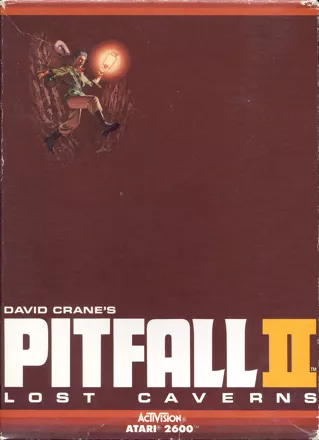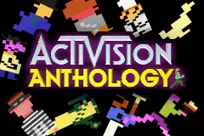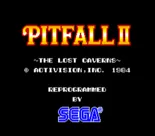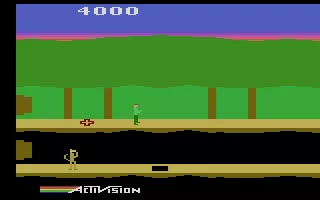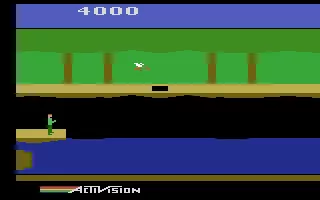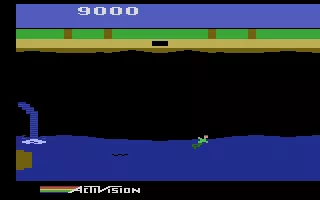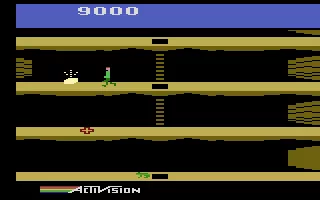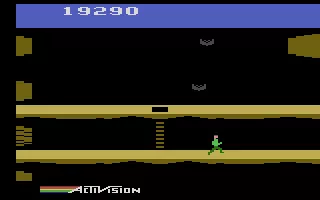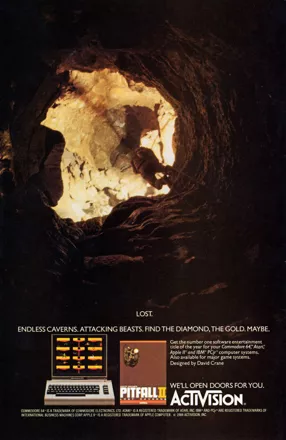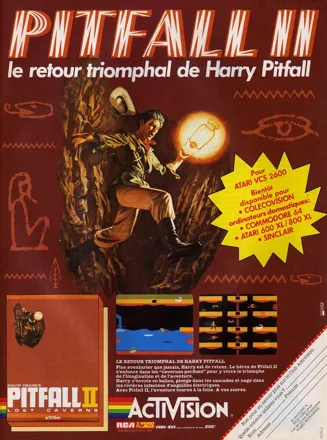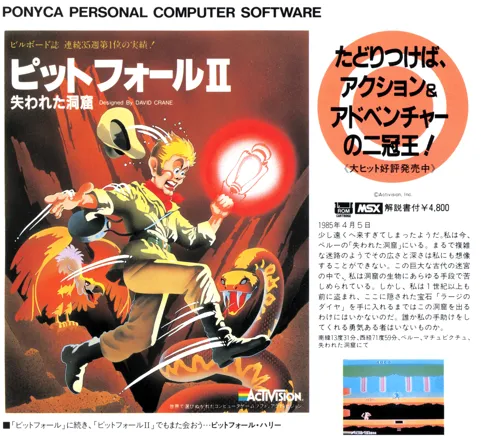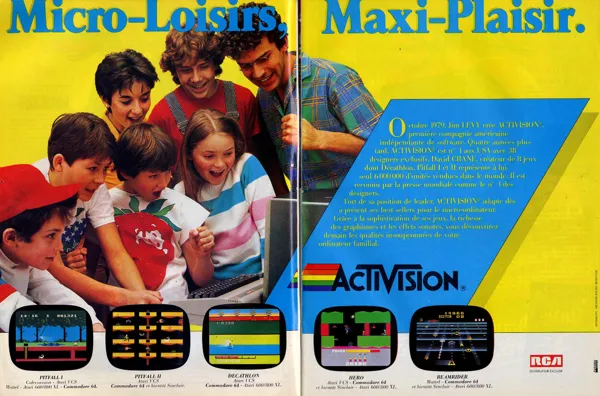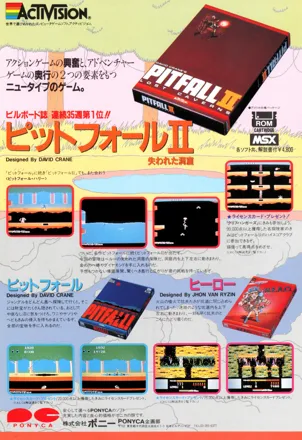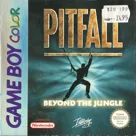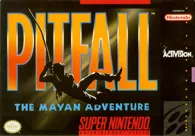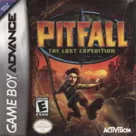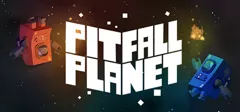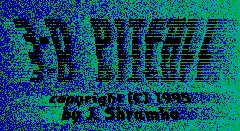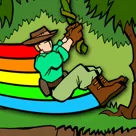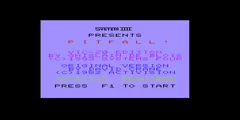Pitfall II: Lost Caverns
Description official descriptions
You play Pitfall Harry searching for the Raj diamond, his niece Rhonda, her cat Quickclaw and a variety of treasures somewhere in the Andes. Poisonous frogs, eels, scorpions, bats, and other hazards get in the way.
Pitfall II is the sequel to Pitfall!, the original platform game. Gameplay has remained pretty much the same, with each screen presenting a side view of obstacles to get past, and potentially treasures to collect. The landscape is more maze-like, with a variety of paths and dead ends to search. Along the way, there are checkpoints the player will encounter in the form of red crosses. When the player dies, Pitfall Harry will be sent back to the most recently crossed checkpoint. The score is reduced based on the distance traveled to get to the cross.
As he explores Harry can collect gold bars which give him a 5000 points award. His total score acts as an energy reserve. If the score is reduced to zero then the game ends and the player must restart from the beginning.
Spellings
- ピットフォールII - Japanese spelling
Groups +
Screenshots
Promos
Credits (Atari 2600 version)
| Program |
Reviews
Critics
Average score: 81% (based on 17 ratings)
Players
Average score: 3.8 out of 5 (based on 109 ratings with 3 reviews)
Do more things besides collecting gold
The Good
* New characters and enemies
Pitfall II: Lost Caverns introduced us to two new characters besides Harry himself. In the early Eighties, you may or may not watch CBS' Saturday Supercade cartoon series starring the popular video game characters at the time. The Pitfall segments included Quickclaw and Rhonda, and these characters re-appeared in the game. Although Quickclaw is a mountain lion, he reminds me of Wile E. Coyote from the Road Runner cartoons.
* Do more besides running and jumping
What I enjoyed most of the game is that you can do more thing than you did in Pitfall. Sure, you can still jump over scorpions, frogs, and condors right at the very start of the game. But soon, you have to go underground and do even more things such as swim underwater, ride balloons, and rescue other characters. The highlight is jumping off a ledge while pushing the joystick left, and seeing Harry fly across the screen, and ricochet off the rock walls on the other side.
* "Happy" and "Sad" soundtracks
A wonderful addition to Pitfall II is two soundtracks that play during the game. When you start the game, it begins with the "Happy" soundtrack, but eventually transforms to the "Sad" soundtrack. It then picks up again as soon as Harry collects gold or one of the three required items.
* Use of checkpoints
Unlike the original game, Harry has unlimited lives. This means if you come into contact with a creature, you will return to a checkpoint, a red mark on the ground. What's funny about this is the way he returns to these checkpoints. He can fly to them, going through any platforms in the process. The checkpoints are useful for knowing that you are going the right way.
The Bad
There is not an negative thing I can say about the game.
The Bottom Line
Pitfall II is similar to its predecessor, but there is more involved to the gameplay. Besides collecting every piece of gold you find, you have to get three items. New features are introduced, such as the addition of a soundtrack and checkpoints, as well as various ways to navigate the lost caverns.
If you played the original on the 2600 and get bored with it, now is the time to get yourself a copy.
Atari 2600 · by Katakis | カタキス (43085) · 2012
The closest the 2600 ever came to an epic
The Good
With platform gaming still in its primordial, pre-"SUPER MARIO BROS." developmental stage, PITFALL II offered up a surprisingly sophisticated set of challenges: timing your long ladder descent to avoid the poisonous toads leaping back and forth, swimming around electric eels, running beneath buzzards that swooped up and down, calculating long jumps and falls to land on the right ledge (that Pitfall Harry must have titanium knees), rising through a cavern shift clinging to a balloon and avoiding bats, and of course our old arch-nemesis: the Giant Scorpion.
By expanding on the Indiana Jones-esque setting and adventure/treasure hunting trappings of its predecessor, and by giving us a concrete end goal (nice touch, having the underground portion of the opening screen be the end of the journey) there was, rare for games at the time, the sense of an actual beginning-middle-end story. And once you learned the patterns and locations of all the key treasures the game didn't take more than a few minutes to solve, but the challenge lay in the score - how many treasures did you ignore when you branched off the path that way, and how many times did you watch your points agonizingly drain as you got hit and sent back to a checkpoint?
Yes - checkpoints. Another thing you didn't see a whole lot of in 1984, but it was the right development for this game's demands.
With the colorful contrast between the above-ground jungle, the underground river and the rocky caverns, this is as much graphical oomph as you ever saw from old Stella. And a soundtrack, even! On a gaming platform that rarely had more to say than "Bloop", the wizards at Activision managed to pack in a stirring little heroic melody that chimed whenever you picked up some loot. And that same song got transposed into a mournful minor key whenever you "died" - so you longed to scoop another gold bar and get back to the happy version again. Child's play now, sure, but damned clever motivation for the time.
The Bad
With something this good, you could only wish for more, and the game, once you learn it, is far too short. The influence of the first two PITFALL games is undervalued, I think, and the tragedy is that while the franchise went through all sorts of clumsy permutations on its way to the modern era, the video game medium has passed its now seemingly-simple achievements by. Even a super-fantastic modern day game that out TOMB RAIDER'd TOMB RAIDER would just be carrying the name. It wouldn't be PITFALL.
The Bottom Line
Nowadays you can play games that have 10-, 20- or 30- hour storylines, and almost never will you see them not come to some concrete conclusion. But narratively speaking, it took gaming awhile to reach this development, games either spun out to a computational infinity or smacked against some memory limit wall that only the best players could reach anyway.
Activision was one of the first companies tinkering with this, and in PITFALL II: THE LOST CAVERNS you had a legitimate storyline to hang your hat on. Unlike the otherworldly abstractions of a PAC-MAN, it wasn't difficult to fire your imaginations off of Pitfall Harry. Even if he was just a stick figure in a dorky green shirt, he got himself into some awesome adventures.
The triumph of this game is really two-fold. Not only did it give you an "end": a real achievement to celebrate. But in presenting you options in how you reached your goal, and by scattering treasures throughout to tempt you towards a higher score, it provided something that any game with an "end" needs:
Replay value.
Atari 2600 · by TheoryOfChaos (23) · 2006
The Good
Everything. PC at those times was very popular but it was known as 'not-so-good' for arcade games. There were lot of arcade game ports on PC, but almost everything was in much poorer quality compared to other platforms.
But Pitfall II shown that arcade can be made in top quality also on PC. This was not possible without using new PC hardware of 1984 year. It means PCjr or Tandy. And indeed, Pitfall II was using those new capabilities perfectly. I'm not talking only about graphics (320x200, 16 colors), but also about sound and music (PCjr/Tandy 3-way sound support, no annoying speaker beeps!). Together with joystick support (can be easily emulated in DOSBox with any controller), I found playing Pitfall II very enjoyable even now in 2023. Can't wait to setup new HTPC and to run it on 50+" TV with controller! Graphics perfect, sound/music perfect, controller support perfect, gameplay perfect.
The Bad
Really nothing. I tried lot of oldies-goldies PC titles from that era, and this one stands out. At least between arcade games. Many PC arcade ports were really lazy and were using just CGA+beeper even if better HW was already available (probably business decision to earn lot of money by addressing most of PC players). In contrary Pitfall II is great port which is doing everything right.
The Bottom Line
Just don't forget to setup DOSBox / DOSBox-x as Tandy machine (and enable Tandy sound). Plus I found that game has ok speed even on fast emulation but joystick reading is crap with lot of cycles. Setting cycles to around 400 fixed that. Then I was just enjoying this quality arcade game.
PC Booter · by Vladimir Dienes · 2023
Discussion
| Subject | By | Date |
|---|---|---|
| Apple II game supported the Mockingboard sound card | Andrew Fisher (700) | May 23, 2023 |
| Maybe this game should be split... (Arcade, SG-1000?) | Spiderkeys (188) | Aug 7, 2015 |
Trivia
Display Processor Chip (DPC)
"Pitfall 2" was the first and only game that use a DPC-enhanced cartridge. David Crane designed a special circuitry that could be built into a game cartridge, significantly enhancing the power of the Atari 2600. All the advanced features of the game were a direct result of the chip such as extra graphics capabilities, four-voice music and vertical scrolling.
High score reward
If the player sent proof of a score of 99,000 points or more for the Atari 2600 version of the game, they would be rewarded with a Cliff Hangers patch. Here is a picture of that patch at AtariAge.
Method of Porting Apple II version
In his Game Developer Research Institute interview, Rex Bradford, the developer who ported Pitfall II to the Apple II platform from the Atari 2600, mentions that they ignored the source code they were provided with and re-wrote the game from scratch after studying the game play of the original.
C64 and Atari 800 ports
Tim Shotter, who was responsible for the C64 port, took a traditional approach writing the game from scratch using completed 2600 release as a specification while Mark Lorenzen, resposible for Atari 800 port, decided to do things differently. He wrote display code that replaced Atari 2600 display routines and used David's Crane original code intact. Both ports reached beta stage at the same time but because C64 version had been written from scratch, the code needed debugging what lasted about two months. As for Atari 800 it was not necessary and these two months of waiting for the debugged C64 version gave the opportunity to enhance Atari 800 version with addition of entirely new original level.
Awards
- Retro Gamer Magazine
- (Issue 46) - #1 'Top 25 Atari 2600'
- Zzap!
- May 1985 (Issue 1) - #56 'It's the Zzap! 64 Top 64!'
Analytics
Related Sites +
Identifiers +
Contribute
Are you familiar with this game? Help document and preserve this entry in video game history! If your contribution is approved, you will earn points and be credited as a contributor.
Contributors to this Entry
Game added by Servo.
Windows, Xbox 360 added by Alaka. Atari 8-bit added by Terok Nor. MSX added by koffiepad. Atari 5200 added by Jeanne.
Additional contributors: PCGamer77, Alaka, formercontrib, LepricahnsGold, roughana, mailmanppa, Karsa Orlong, FatherJack, robMSX.
Game added August 10, 2002. Last modified February 25, 2025.


